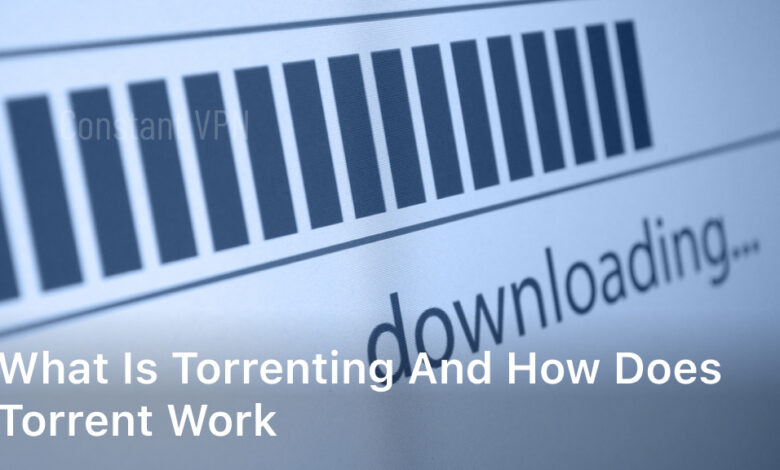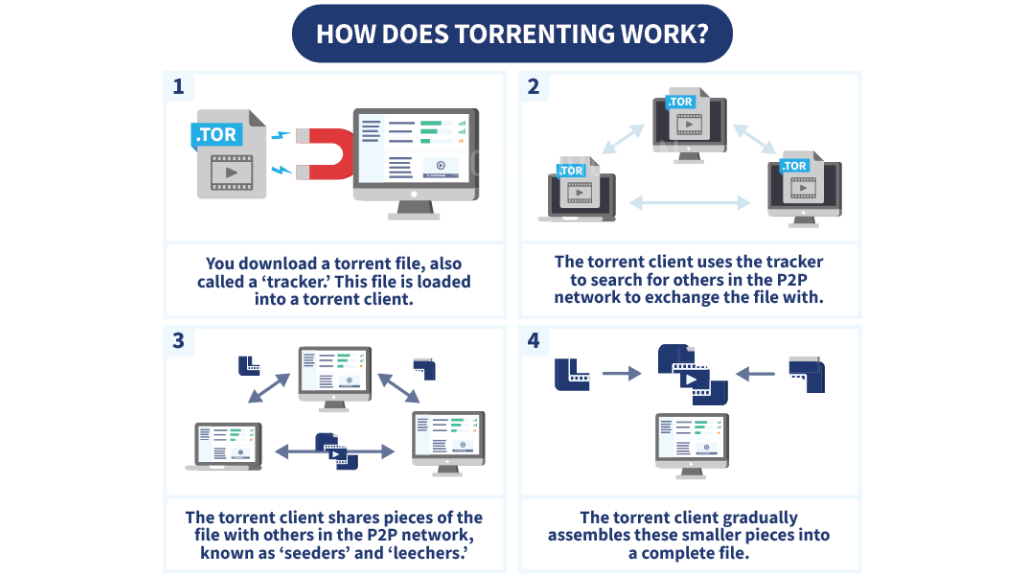
Welcome to our guide on torrenting, where we will explain what it is and how it works. Torrenting is a popular method of peer-to-peer file sharing, allowing users to download files from multiple sources simultaneously.
In a nutshell, torrenting involves breaking down a large file into small parts and distributing those parts among various users. This decentralized sharing process ensures faster and more efficient downloads compared to traditional file-sharing methods.
Peer-to-peer file sharing relies on a network of users, known as “peers,” who share files with each other. Instead of relying on a central server, torrenting utilizes the combined computing power and bandwidth of these users to facilitate downloads.
When you initiate a torrent download, your computer joins a swarm of other computers that already have or are currently downloading the same file. Each computer contributes a small portion of the file, and as more users join the swarm, the download speed increases.
In essence, torrenting harnesses the power of many to distribute and download content efficiently and quickly. It has become the go-to method for downloading large files, such as movies, music, software, and more.
Now that you understand the basics of torrenting, let’s delve deeper into how it works and explore the various aspects of this fascinating technology.
How Does Torrenting Work?
In this section, we’ll take a closer look at how torrenting works and explore the key components involved in the process. Understanding the mechanics of torrent downloads is essential for anyone interested in utilizing torrenting sites and software.
Torrent Downloads:
At the heart of torrenting is the concept of peer-to-peer file sharing. When you download a torrent file, you are essentially connecting to a network of users who have the same file or files you are seeking. This decentralized network allows for faster and more efficient downloads, as files are distributed among multiple users.
When you initiate a torrent download, your torrent client software connects to different peers, requesting small pieces of the file from each one. As these pieces are received, your client software combines them to create the complete file on your device. Simultaneously, your client software also uploads the pieces you have received to other peers in the network, contributing to the overall efficiency of the process. This principle of sharing as you download is what sets torrenting apart from traditional file downloads.
Torrenting Sites:
To find and access the files you want to download, you’ll typically rely on torrenting sites. These websites host or index torrents, which serve as pointers to the files available for download. Torrenting sites provide a searchable database of torrents, categorizing them by different criteria such as genre, popularity, or file type.
However, it’s essential to note that not all torrents are legal or safe, as copyrighted material may be shared without authorization. It’s crucial to exercise caution and use reputable torrenting sites, ensuring you are downloading files that are legally and ethically shared.
Torrenting Software:
The process of torrenting requires specialized software known as torrent clients. These software applications facilitate the connection between your device and the torrent network. They handle the downloading and uploading of the file pieces, manage the connections with other peers, and provide a user-friendly interface for organizing and monitoring your downloads.
There are various torrenting software options available, each with its own set of features and user interface. Some popular examples include uTorrent, BitTorrent, and Vuze. When choosing a torrent client, consider factors such as ease of use, platform compatibility, and additional features like bandwidth management and scheduling options.
Now that you have a better understanding of how torrenting works, let’s explore the legal aspects in the next section, where we’ll discuss the potential risks and consequences of engaging in illegal torrenting activities.
Understanding Torrenting Legality
When it comes to torrenting, understanding the legal implications is crucial. While torrenting itself is not illegal, the legality primarily depends on the content being shared and the jurisdiction you are in. Engaging in illegal torrenting activities can have serious consequences, including fines and legal action.
It’s important to recognize that torrenting can be used for both legitimate and illegal purposes. Many users rely on torrents for sharing open-source software, public domain content, or files with the necessary permissions. However, downloading copyrighted materials without proper authorization is considered illegal.
Authorities and copyright holders actively monitor torrenting activities and target individuals who infringe on copyrights. This means that engaging in illegal torrenting can expose you to legal risks. It’s essential to educate yourself about the copyright laws in your country and use torrents responsibly and legally.
- 1. Familiarize yourself with copyright laws: Research and understand the copyright laws in your country to ensure your torrenting activities comply with the legal requirements.
- 2. Avoid downloading copyrighted content without permission: Stick to legal sources or content that is explicitly authorized for sharing through torrents.
- 3. Use VPN for privacy: Employing a virtual private network (VPN) can help protect your identity and maintain your privacy while torrenting.
- 4. Select reputable torrenting sites: Choose well-known torrenting sites with a good reputation for hosting legitimate content and maintaining strict adherence to copyright laws.
- 5. Consider using legal alternatives: Explore legal alternatives such as streaming services, online stores, or authorized platforms for accessing copyrighted content.
By understanding and respecting the legal boundaries of torrenting, you can enjoy the benefits of peer-to-peer file sharing while avoiding potential legal troubles. Remember to always prioritize legality, respect intellectual property rights, and use torrents responsibly.
Managing Torrenting Risks
When it comes to torrenting, there are inherent risks and security concerns that users need to be aware of. While torrents offer a convenient way to share and download files, it’s important to take precautions to protect your online safety and avoid any legal consequences.
To help you navigate through these risks, we’ve compiled a list of best practices to ensure a safer torrenting experience:
- Use a VPN: A Virtual Private Network (VPN) encrypts your internet connection, making it harder for others to monitor your online activities. It also allows you to mask your IP address, adding an extra layer of privacy and security.
- Verify file sources: Before downloading a torrent file, check the comments and reviews to verify its authenticity. Avoid downloading from suspicious or unfamiliar sources.
- Scan files for malware: Use reputable antivirus software to scan downloaded files for any potential malware or viruses. This will help protect your computer and personal information.
- Regularly update your software: Keep your operating system, web browser, and torrenting software up to date. Software updates often include security patches that can address vulnerabilities.
- Avoid public Wi-Fi: Public Wi-Fi networks can be insecure, making it easier for hackers to intercept your data. Stick to using torrenting sites and downloading files from the safety of your home network.
- Be cautious with torrenting sites: Stick to well-known and reputable torrenting sites. Avoid clicking on suspicious ads, pop-ups, or links that may lead to malicious websites.
- Know the laws: Familiarize yourself with the legalities surrounding torrenting in your country. Understand the consequences of engaging in illegal activities and always respect copyright laws.
By following these tips, you can minimize the risks associated with torrenting and enjoy a safer and more secure file-sharing experience.
Navigating Torrenting Sites
When it comes to torrenting, finding reliable and reputable sources for torrent downloads is essential. Navigating torrenting sites can sometimes be overwhelming, but with the right approach, you can discover a world of content at your fingertips. Here are some tips to help you navigate torrenting sites effectively:
- Research before you visit: Before accessing any torrenting site, it’s important to do some research and gather information about its reputation, user feedback, and safety measures. Look for websites that have positive user reviews and are known for providing high-quality torrents.
- Use trusted torrenting site directories: Instead of randomly searching for torrenting sites, consider using trusted directories that curate and list reliable sources. These directories categorize torrent sites based on popularity, safety, and quality, making it easier for you to find the content you’re looking for.
- Read user comments and ratings: User comments and ratings can provide valuable insights into the reliability and authenticity of a torrenting site. Take the time to read through user feedback to assess the overall user experience and identify potential risks or issues.
- Look for verified torrent tags: Many torrenting sites employ a verification system that marks torrents as “verified” or “trusted.” These tags indicate that the torrent has been reviewed and confirmed to be legitimate, reducing the risk of downloading malware or low-quality content.
- Keep an eye on seeders and leechers: Seeders and leechers play a crucial role in torrenting as they determine how fast you can download a file. Look for torrents with a high number of seeders and a low number of leechers, as this indicates a healthy and active torrent community.
By following these tips and being cautious while navigating torrenting sites, you can enhance your torrenting experience and minimize the risks associated with downloading files through peer-to-peer networks.
Choosing the Right Torrenting Software
When it comes to torrenting, having the right software is crucial for a seamless and efficient downloading experience. With a plethora of options available, it’s important to choose the torrenting software that best suits your needs. Let’s explore some popular torrent clients and their features to help you make an informed decision.
1. BitTorrent
BitTorrent is one of the most well-known and widely-used torrent clients. It offers a user-friendly interface and allows for fast and efficient file sharing. With BitTorrent, you can easily manage your downloads, prioritize files, and even stream media while the download is in progress.
2. uTorrent
uTorrent is another popular torrent client that offers a lightweight and feature-rich experience. It boasts a clean and intuitive interface, making it easy to navigate and manage your downloads. uTorrent also provides advanced options for customization, such as scheduling downloads and remote access via a web interface.
3. qBittorrent
qBittorrent is an open-source torrent client that strives to provide a free and ad-free experience. It offers a simple and straightforward interface, making it ideal for beginners. qBittorrent also supports various operating systems and offers features like sequential downloading and IP filtering.
4. Deluge
Deluge is a cross-platform torrent client that offers a lightweight and customizable interface. It supports a wide range of plugins, allowing you to enhance its functionality according to your preferences. Deluge also offers advanced features like encryption and remote access via a web interface.
5. Vuze
Vuze, formerly known as Azureus, is a feature-packed torrent client that caters to both beginners and advanced users. It offers a comprehensive set of tools and options for downloading, streaming, and managing media files. Vuze also supports media playback and provides social features for sharing files and recommendations.
Remember, the right torrenting software ultimately depends on your specific requirements and preferences. Consider factors like user interface, customization options, additional features, and platform compatibility when selecting the best torrent client for you. With the right software in hand, you can enjoy efficient and hassle-free torrenting.
Conclusion
Now that you have a better understanding of torrenting, you’re ready to embark on your file-sharing journey. Remember, torrenting is a peer-to-peer file-sharing method that allows you to download and share large files efficiently.
To get started, you’ll need torrenting software such as BitTorrent or uTorrent. These programs enable you to connect to torrenting networks and manage your downloads. Simply install the software, find a reliable torrenting site, and search for the file you want to download.
It’s important to note that while torrenting is a convenient way to access a wide range of files, there are legal considerations to keep in mind. Make sure to download and share files that are copyright-free or authorized for distribution. Additionally, always prioritize your online security by using a VPN and being cautious of malicious files.
By following these guidelines, you can enjoy the benefits of torrenting while minimizing the potential risks. Happy torrenting!
FAQ
What is torrenting?
Torrenting is a method of peer-to-peer file sharing that allows users to download and share files through a decentralized network. It works by breaking down large files into smaller pieces and distributing them across multiple computers (known as “peers”) connected to the network.
How does torrenting work?
When you want to download a file using a torrent, you first need to find a torrent file or magnet link for that file. This file contains information about the file you want to download and the sources (peers) that have it. With the help of torrenting software, you can connect to the network and start downloading small pieces of the file from multiple peers simultaneously. As you download, you also upload parts of the file to other peers, creating a cooperative sharing ecosystem.
Is torrenting legal?
Torrenting itself is a neutral technology, but it can be used for both legal and illegal purposes. While sharing and downloading copyrighted material without permission is often illegal, there are legal torrenting sites and content available, such as open-source software or files that have been licensed for distribution. It’s essential to understand and respect copyright laws in your country and use torrenting for lawful purposes.
What are the risks of torrenting?
Torrenting comes with certain risks, such as downloading infected or fake files that may contain malware or viruses. Additionally, engaging in illegal torrenting activities can result in legal consequences, including fines or even legal action. It’s crucial to use antivirus software, stick to trusted torrenting sources, and be mindful of what you download to minimize these risks.
How can I find reliable torrenting sites?
When looking for torrenting sites, it’s advisable to stick to well-established and reputable platforms. User reviews and ratings can also help determine the reliability of a torrenting site. Some popular and trusted torrenting sites include The Pirate Bay, 1337x, and RARBG. However, it’s important to note that accessing copyrighted content without proper authorization is illegal, even if the site itself is legitimate.
What torrenting software should I use?
There are several torrenting software options available, each with its own features and user interface. Some popular choices for torrent clients include uTorrent, BitTorrent, and Vuze. When selecting torrenting software, consider factors like ease of use, available features, platform compatibility, and user reviews.
How do I get started with torrenting?
To get started with torrenting, you’ll need to follow these basic steps: 1. Choose and install a torrenting software. 2. Find a reliable torrenting site or search engine. 3. Download the torrent file or magnet link for the desired content. 4. Open the torrent file or enter the magnet link in your torrenting software. 5. Select the files you want to download. 6. Wait for the download to complete, and enjoy the content responsibly.






